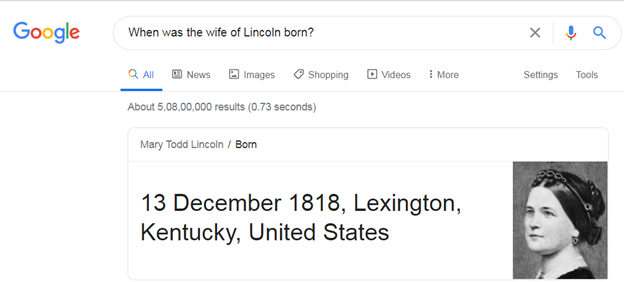Google is primarily established to assemble data about everything possible from people to animals, movies, events, history, and what not with the help of authoritative sites like Wikipedia. The goal is to develop a warehouse of knowledge that people can access easily, no matter what platform the searcher uses and wherever they may be.
Google’s goal is to provide users with more immediate information about what they’re looking for, and there is nothing new, this has been a core objective right from the beginning. Toward that end, Google’s Knowledge Graph is created which helps searchers to find any information on the Search Engine Result Pages (SERPs) easily and quickly.
Here’s an example:

We’ve entered a query ‘when was the wife of Lincoln born?’ in the search results and discover a pool of information on her date of birth, place of birth, picture, and so on. Although we didn’t mention Mary Todd Lincoln’s name, the Google algorithms understood on its own that Lincoln refers to Abe Lincoln and his wife Mary Todd. Isn’t it great?
With this example, you might have experienced the power of its Knowledge Graph, but it is worth nothing if you aren’t aware of how you can leverage and influence this knowledge database. But first, let’s take a look at what Google’s Knowledge Graph exactly is and how does it work.
What is Google’s Knowledge Graph?
The Knowledge Graph is a mechanism that allows algorithms to understand the connection between different places, people, buildings, movies, celestial objects, works of art, and other things – and gives information that’s most relevant and accurate to the searchers’ query.
To make your learning process simpler, just go to Google and search for ‘famous Hollywood actors’ into the search box. You will see a picture carousel that displays at the top.

The Knowledge Graph is considered good news for both users and Search Engine Optimization (SEO) experts. On one hand, users can attain relevant search results while SEOs can drive qualified traffic to their website.
Let’s take a look at some ways how the Knowledge Graph dominates the search:
1. Google Focuses on Search Intent
We all need to admit that people aren’t likely to search in the same way. And that’s where the Knowledge Graph comes into play, it goes beyond keyword matching to deliver the most relevant search results to the users.
Let’s take a simple query “a wizard that discovered twelve uses of dragon’s blood.”

Even though we didn’t mention Harry Potter or Dumbledore character, Google still knows what we’re looking for and deliver the relevant results.
2. Making Sense in Voice Searches
According to Think with Google, the Google Assistant is now built into more than 1 billion devices (Google Home Data, 2019) which means Google is intended to make more sense of voice searches than ever before. Just take a moment and type a voice query, and get the results.
Here we’ve entered a voice query, ‘who played Hermione in Harry Potter?’

As Hermione and Harry Potter are well-connected entities, it is convenient for Google to pull out everything we’re looking for.
3. More Brand Visibility and Credibility
The Knowledge Graph data in SERP add more power to features like Knowledge Panels and Knowledge Cards. As we have mentioned renowned company ‘Microsoft,’ you could also find your brand’s logo and other data buzzing in the SERP. This can help you to gain better authority, rankings, and trust among searchers.

By now, you might have understood the certain benefits of the Knowledge Graph. So you shouldn’t miss any opportunity to get into it and improve your SEO performance. Here are a few things to do:
4. Use Schema Markup on Your Homepage
Though schema markup is invisible to users, it could be a convenient way to let the Knowledge Graph access data about your business. Enter all the requisite information like a person, organization, etc. to stand a better chance of visibility in SERPs.
5. Get Your Business Listed at Wikipedia
You may have experienced by now that Google usually borrows the company’s description from Wikipedia and Wikidata.org. So it goes without saying, make an entry on these convincing sites to build authority.
6. Verify Your Social Media Accounts
Even when Google couldn’t find your official website, you may still have a chance to appear on the results if your social media accounts are well identified and verified. Thus, you should keep the information up to date on platforms like Facebook, LinkedIn, Twitter, etc. to step ahead.
7. Be Active and Consistent
The way you provide information to Google through your blog posts, videos, infographics, etc. you will definitely see superior results. If you can’t publish content at least once a week or don’t have adequate time to track your performance, acquiring SEO services could be a viable option. Your goal should be to balance the social, SEO, and content in order to make the best out of the Knowledge Graph.
Conclusion:
Google’s Knowledge Graph cards have been capturing searchers’ attention through local 3-packs, featured snippets, carousels, rich snippets, AdWords ads, videos, and more. While you can’t agree more on Google has done a wonderful job at predicting what we want to see, it does add a challenging factor for all levels of enterprises. The best way to appear on the top in the SERPs is to focus on users’ needs and create an exceptional experience for them.

